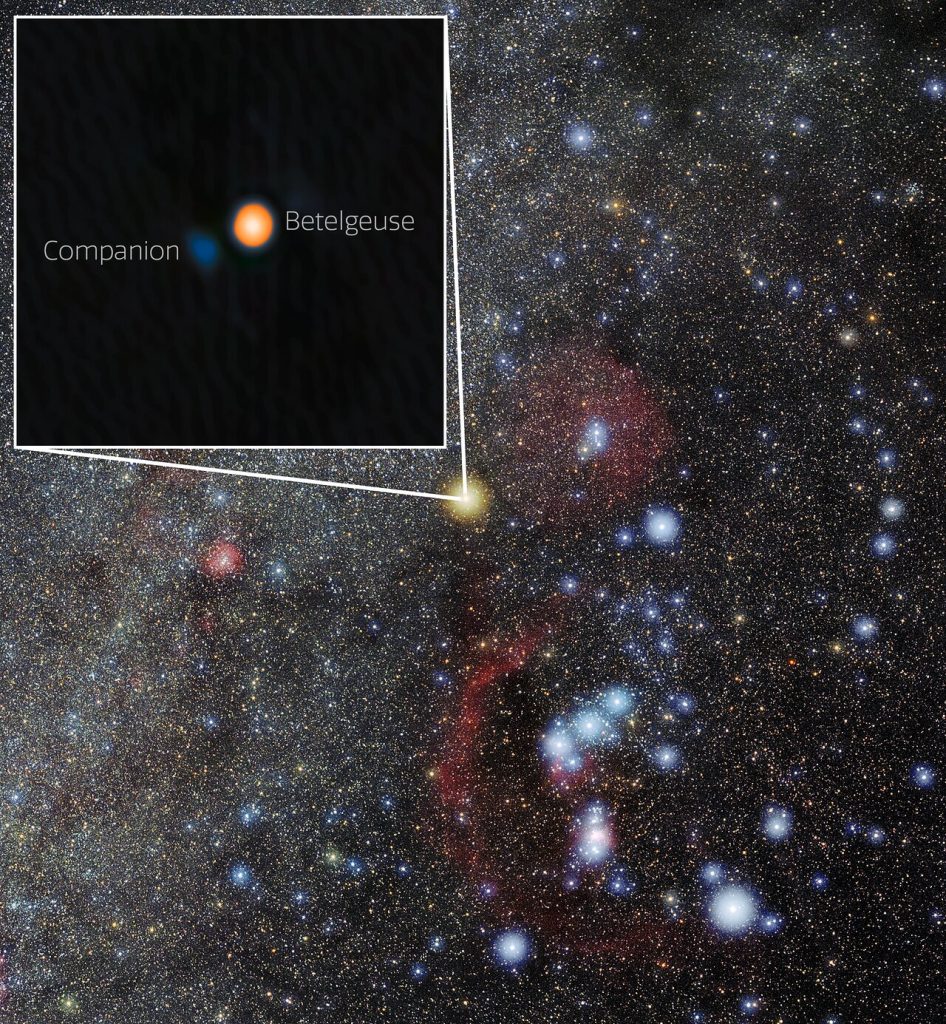Discovered using the Gemini North telescope, this finding resolves a century-old mystery and paves the way for new research into red supergiant Betelgeuse.
Key Takeaways:
- Using the Gemini North Telescope’s speckle imager, ‘Alopeke,’ astronomers directly captured an image of a previously hypothesized companion star to Betelgeuse, situated roughly 4 AU from the red supergiant.
- The companion is estimated to be an A- or B-type pre–main-sequence star with roughly 1.5 solar masses, considerably fainter than Betelgeuse in visible wavelengths.
- The finding provides a possible explanation for Betelgeuse’s six-year variability cycle, indicating that the companion may affect the distribution of dust in the red supergiant’s extended atmosphere.
- The future of this close binary system may see Betelgeuse ultimately engulfing its companion within the next 10,000 years, potentially altering the red supergiant’s evolutionary path and the timing of its eventual supernova.
On July 21, 2025, NSF NOIRLab announced that astronomers had detected the long-sought companion star of the red supergiant Betelgeuse. The discovery was made by a team of astrophysicists led by Steve Howell, senior research scientist at NASA’s Ames Research Center. Using ‘Alopeke,’ a speckle imager on the Gemini North Telescope atop Maunakea in Hawai‘i, the team successfully observed Betelgeuse’s elusive companion.
An iconic star Betelgeuse
Betelgeuse is one of the most celebrated stars in the night sky, renowned not only for its striking reddish hue and position at Orion’s shoulder, but also for its turbulent and unpredictable behavior. Situated roughly 650 light-years away, this stellar giant spans nearly 700 times the radius of the Sun. Despite being only about 10 million years old, Betelgeuse is already approaching the final stages of its life. For millennia, humans have observed its fluctuating brightness, which astronomers have linked to a 400-day pulsation cycle and a second, slower rhythm lasting approximately six years.
The Great Dimming of Betelgeuse
The longer six-year cycle drew fresh attention in 2019 and 2020, when Betelgeuse dimmed so dramatically that some speculated a supernova could be imminent. This phenomenon, dubbed the “Great Dimming,” was eventually attributed to a veil of dust expelled by the star itself. Nevertheless, it spurred astronomers to examine more closely what might be hidden within Betelgeuse’s glow.
Two papers published in 2024 analyzed decades of photometric and spectroscopic data collected by observers around the world. Both studies concluded that Betelgeuse’s six-year variability is best explained by the presence of a smaller, fainter companion star orbiting undetected within the red supergiant’s extended atmosphere. Such a companion could shepherd dust into certain regions along its orbit while clearing it from others, periodically dimming Betelgeuse from our perspective.
Previous attempts to detect this hypothesized star using Hubble and Chandra had come up empty—until now.
Discovering Betelgeuse’s old friend
Using Gemini North and its speckle imager ‘Alopeke, Howell’s team has finally detected what previous studies could only infer. Speckle imagers like ‘Alopeke—Hawaiian for “fox”—take rapid sequences of short exposures to counteract atmospheric turbulence, combining them into a single high-resolution image that would otherwise be impossible from Earth. Under ideal conditions and with Gemini North’s 8.1-meter mirror, the team successfully captured Betelgeuse’s faint stellar companion directly for the first time.
The newly imaged star lies just 52 milliarcseconds—or 0.000014°—from Betelgeuse as seen from Earth. In physical terms, it orbits roughly four astronomical units (AU) from the red supergiant, placing it between the outer edge of the main asteroid belt and Jupiter in our solar system. (One AU is the average distance between Earth and the Sun.) This means the companion resides well within Betelgeuse’s extended outer atmosphere.
The companion is estimated to have roughly 1.5 times the mass of the Sun and is six magnitudes fainter than Betelgeuse (magnitude 0.5) in visible light. Its color and brightness suggest it is an A- or B-type pre–main-sequence star—a hot, blue-white star that has not yet initiated hydrogen fusion in its core.
“This detection pushed Gemini to the very limits of high-angular-resolution imaging—and it succeeded,” Howell said. “It now paves the way for other observational studies of a similar kind.”
Implications for red supergiant
The discovery also provides a new perspective on the variability of red supergiants. Stars like Betelgeuse often exhibit puzzling long-term brightness changes, and Howell’s team suggests that a close-in companion could help explain at least some of these cycles.
Understanding the cause of these variations is critical, as it affects estimates of the star’s size, evolutionary stage, and proximity to a supernova event. For instance, if Betelgeuse’s six-year variability were intrinsic rather than influenced by a companion, the star could be evolved enough to potentially explode within a few dozen to a few hundred years.
However, if a companion star is driving the long-term variability, Betelgeuse is still in an earlier stage of its evolution and may not explode for hundreds of thousands of years.
Although astronomers have long suspected that some red supergiant host binary partners, this is the first time a companion has been directly imaged orbiting so close—well within the star’s extended atmosphere.
A doomed dance
Betelgeuse and its companion likely formed together, but their fate will be far from harmonious. The team’s analysis suggests that strong tidal forces will eventually drag the smaller star into the supergiant’s outer layers, dooming it to be consumed within the next 10,000 years. This event could further destabilize Betelgeuse and potentially hasten its eventual supernova.
Astronomers will have their next prime opportunity to observe the companion in November 2027, when it reaches its greatest elongation—its farthest and most easily detectable separation from Betelgeuse. Howell and his team encourage the scientific community to study the system at that time to refine measurements of the companion’s orbit and characteristics.
The giant’s bracelet
Although the companion has not been officially named, the research team has suggested a poetic designation. Since Betelgeuse’s name likely originates from the Arabic for “Hand of the Giant,” with ‘Elgeuse’ historically serving as a feminine name for Orion, they propose naming the new companion سوارها—Arabic for “Her Bracelet.”
“These results are not yet definitive, as the detection pushes the limits of the instrument’s capabilities,” the team notes. “Nonetheless, they provide the most direct and compelling evidence to date for the existence of a stellar companion to Betelgeuse, along with its key properties.”



